Raspberry Pi
Raspberry Pi is a family of low cost single board computers (SBC) developed in the UK by the Raspberry Pi Foundation
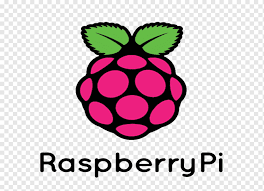
Originally the promotion of computer science education in schools was sought
But it has become more popular in the personal computer market
It is even sold as robotics or home automation components
One of its characteristics is that it does not include peripherals (such as keyboard, mouse or case), these components must be purchased separately
Its accessories have been included in official and unofficial packages
Description
It is not expressly indicated whether it is free or trademarked hardware
In your official web They explain that they have distribution and sale contracts with two companies, but at the same time anyone can become a reseller or redistributor of Raspberry Pi cards
Therefore, it implies that it is a product with registered property, maintaining control of the platform, but allowing its free use both at an educational and private level.
On the other hand, the software is open source, its official operating system being an adapted version of Debian, called Raspberry Pi OS, although it allows the use of other operating systems, including a version of Windows 10
In all its versions, it includes a Broadcom processor, RAM, GPU, USB ports, HDMI, Ethernet (the first model did not have it), 40 GPIO pins (from the Raspberry Pi 2) and a camera connector
None of its editions includes memory, this being in its first version an SD card and in later editions a MicroSD card
The foundation supports downloads of ARM architecture distributions:
- Raspberry Pi OS (derived from Debian)
- RISC OS 5
- Arch Linux ARM (derived from Arch Linux)
- Pidora (derived from Fedora)
Mainly promoting learning the Python language
It also supports Tiny BASIC, C, Perl and Ruby languages
Raspberry Pi Foundation developed the first models
After the release of the Raspberry Pi 1 Model B, the Raspberry Pi Trading was created and Eben Upton as CEO during the development of the Raspberry Pi Model 1 B+
Raspberry Pi Trading is responsible for developing the technology
The foundation is a non profit educational organization, which aims to promote the teaching of computer science in schools and developing countries
Sale of units
According to the Raspberry Pi Foundation, more than five million Raspberry Pi were sold in February 2015, making it the best selling British computer
November 2016, they sold 11 million units, and 12.5 million in March 2017, being the third best selling “general purpose computer”
July 2017, sales reached about 15 million
March 2018, sales reached 19 million
Most Raspberry Pis are built in a Sony factory in Pencoed, Wales; the rest are manufactured in Asian countries such as China or Japan
Models
Model A
Raspberry Pi 1 Model A (discontinued)
Raspberry's first model, started selling in 2012
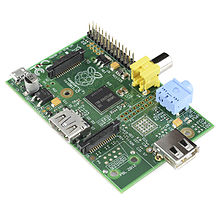
It lacked an Ethernet port, so it required a USB Wi-Fi adapter to connect to the Internet
It had 26 GPIO connectors, video output via HDMI and Video RCA, a 3.5-millimeter Jack connector, a single USB connector, MicroUSB (for power) and a camera connector
Its processor was a Broadcom BCM2835, Single-Core at 700MHz
It also had 256 MB of RAM and a Broadcom VideoCore IV chart
It required a 5-volt, 2-amp power supply, a common element to other versions
Its initial cost was 40 euros
Raspberry Pi 3 model A+
Announced in November 2018
A+ models have lower performance so their price is lower
It has 512 MB of RAM (shared with the VideoCore IV GPU), a single USB port and lacks a wired network connection (RJ-45)
Model B
Raspberry Pi 1 Model B (discontinued)
It appeared in 2012, is a variant of the Model A, which included several improvements, such as a double RAM, from 256 MB to 512MB
An additional USB port and Ethernet connector (RJ-45), so internet access was now possible without peripherals
It remained both in size and cost
There were no variations on the processor or the graphics
Raspberry Pi 1 model B+ (discontinued)
A short time later the Model B+ was launched, it is a variant of Model B with little modification
It included 4 USB ports and changed the SD memory to a MicroSD
Raspberry Pi 2 Model B
It was released in 2014 and is the first model to use the BCM2836 processor, different from the previous three, but from the same manufacturer
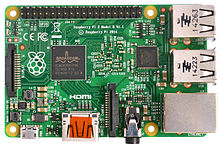
It goes from one core to four, and from 700 MHz to 900 MHz
However, it uses the same graph, the VideoCore IV
Doubles the amount of RAM, from 512MB to 1GB
Although because this memory is shared with the graph, there is really something less
It also includes 40 GPIO pins, keeping all four USB ports
RCA connection is deleted
Raspberry Pi 3 Model B
It came to light in 2016, renewing its processor, once again from broadcom company
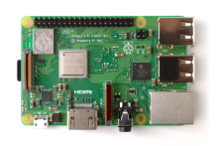
It was a Quad-Core, but it goes from 900 MHz to 1.20 GHz
Keeps RAM at 1GB
Its biggest novelty was the inclusion of Wi-Fi and Bluetooth (4.1 Low Energy) without the need for peripherals
Raspberry Pi 3 Model B+
It appeared in March 2018 to update the Raspberry Pi 3 Model B and among its improvements features a new processor and better connectivity
Going from 1.2 Ghz to 1.4 Ghz and in terms of wireless connectivity now incorporates dual band, 2.4 GHz and 5 GHz
Its new Ethernet port triples, from 100 Mbits/s to 300 Mbits/s
Also features Bluetooth 4.2 (Low Energy)
Raspberry Pi 4 Model B
Announced in June 2019
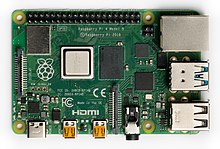
HDMI ports have been replaced by two microHDMI ports
It has the ability to operate a display at 4K at 60 Hz or two 4K displays at 30 Hz
USB 3.0 ports have been included and the Ethernet port is no longer limited to 300 Mbps
Its Broadcom processor is up to three times more efficient than the previous one
Three models are available, depending on their amount of RAM, 2 GB, 4 GB, and 8GB
Raspberry Pi 5 Model B
Announced in September 2023
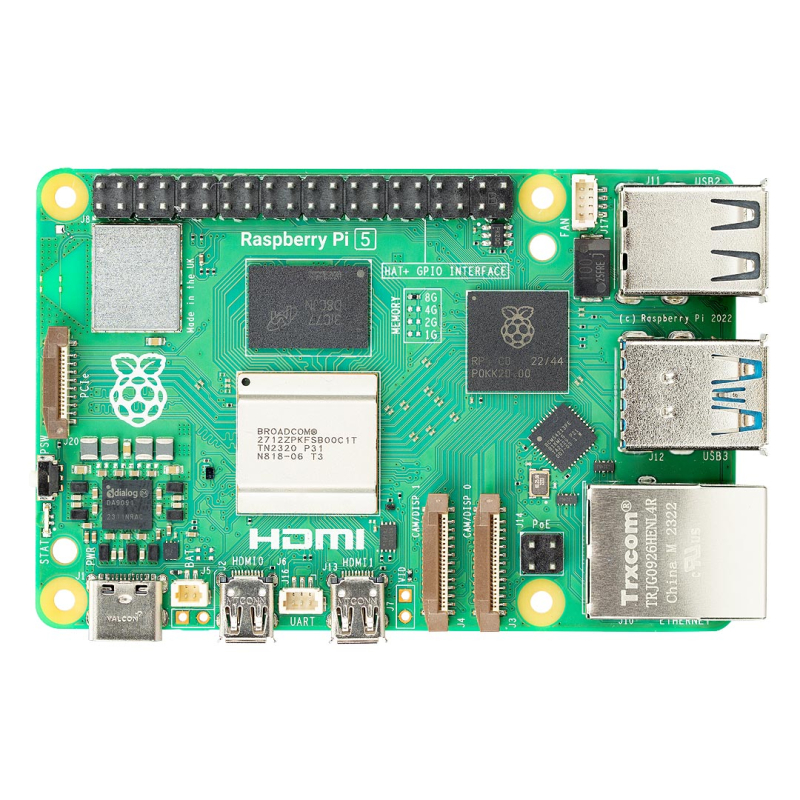
The COVID-19 pandemic forced chip manufacturing plants to close completely or partially, causing a severe shortage of components
Due to this situation, the launch of the Raspberry Pi 5 had to be delayed for two years
There have not been too many technological advances compared to its predecessor the Raspberry Pi 4:
It has a quad-core ARM A76 processor (64 bit – 2.4 GHz) and integrated VideoCore VII 800 MHz GPU for overall performance 2 to 3 times higher than version 4 and greatly improved graphics
New features included on the card, such as the ON/OFF button and PCIe 2.0 port, as well as the integrated RTC connector for even more possibilities and improvements
Completely redesigned and improved connectivity with high-speed Micro-SD port for the OS, 2x simultaneous 4K-60 fps for the display, 2x USB 3.0 5GBps for transfers, etc
Depending on your RAM, there are 2 versions to choose from: 4GB and 8GB (LPDDR4X-4267)
Raspberry Pi Zero
Apart from normal models, the Raspberry Foundation has also taken out another range of boards called Raspberry Pi Zero
They are much smaller and less powerful than their sisters, but it is precisely their attractiveness, less consumption and a much lower price
Pi Zero
It was the first model, released in 2015
Worth $5, it's much smaller than a regular Raspberry, in fact it's smaller than a $5 bill
It's 40% more powerful than the first Raspberry model
Its Broadcom BCM2835 microprocessor operates at 1 GHz with a single core
It has 512 MB of RAM, and shares the VideoCore IV chart
Due to its size it replaces the HDMI port with MiniHDMI
It also doesn't use standard USB, but it has two MicroUSBs, one power and one data
It has RCA output, but instead of per pin there are only two connectors integrated into the board
Use MicroSD as a storage system
Pi Zero W
Es la sucesora de la Pi Zero, la W es por Wireless, ya que la única novedad de esta placa con respecto a su antecesora es la inclusión de Wi-Fi y Bluetooth
Its price is $11
Pi Zero WH
It doesn't make any difference in hardware
The specifications remain the same as the Zero W, apart from the inclusion of a 40-pin GPIO pre-solated connector
Peripheral
Video camera
In May 2012, the foundation reported that it was experimenting with a camera module for Raspberry Pi
The prototype used a 14-megapixel sensor, and was connected to the board's CSI port using a flexible flat cable
In November of the same year, the final prototype was presented at the 2012 Electronic Fair in Munich, and it was disclosed that the sensor would be 5 megapixels and that it could record video at 1080p H.264 at 30 frames per second
The module was finally released on May 14, 2013 at major suppliers
The dimensions of the module are 25 x 20 x 9 mm
In order to make use of it, it has to be activated in raspbian's raspi-config menu
At the end of October 2013, an infrared camera module was also released
Clock
In order to save economic and space costs, Raspberry Pi does not have an internal clock that preserves the time and date when turned off
The Network Time Protocol is used, otherwise the minimum date stored by default is November 30, 1999
Several manufacturers have designed small cards with a DS1302 chip and a CR2032 lithium battery that connect via GPIO port
When booting, the driver software for that device is loaded into memory, consulting the date and time
Testing from time to time while it's running
Other
Peripherals, keyboards, mouse and cases are marketed by companies outside the foundation
For example, the Gertboard, which has been created for educational purposes, serves to make use of the GPIO port and to be able to interact with LEDs, switches, analog signals, sensors and other devices
It also includes an optional controller for Arduino to be able to interact with the Raspberry Pi
Software
Raspberry Pi mainly uses GNU/Linux operating systems
Raspbian, a Debian derived distribution that is optimized for Raspberry Pi hardware, was released in July 2012 and is the distribution recommended by the foundation to get started
Slackware ARM (also called ARMedslack) version 13.37 and later boot without any modification
The 128-4096 MiB of RAM available on the Raspberry Pi covers the 64 MiB of RAM required to boot this distribution on ARM and i386 systems without using a graphical interface (fluxbox window manager operating under X Window System requires 48 MiB of additional RAM)
More specific and lighter distributions such as IPfire (distribution to be used as firewall), 77 or OpenELEC and OSMC (distributions with Kodi Media Center) are being created
The GPU is accessed using a closed-source firmware image (a binary blob), which is loaded into the GPU when booting from the SD card
The file is associated with Linux kernel drivers that are also closed source
Applications make calls to runtime libraries that are open source, and they make calls to open source drivers on the Linux kernel
The kernel driver API is specific to these libraries
Applications that use video make use of OpenMAX, three-dimensional applications use OpenGL ES, and 2D applications use OpenVG; OpenGL ES and OpenVG make use of EGL and the latter, the kernel open source controller
February 19, 2012, the foundation launched a prototype SD card image that stored an operating system and could be loaded into an SD card
The image was based on Debian 6.0 (Squezze), with the LXDE desktop and Midori browser, plus some programming tools
The image worked under QEMU allowing the Raspberry Pi to be emulated on other systems
March 8, 2012, the foundation launched Raspberry Pi Fedora Remix (now called Pidora), which at the time was the distribution recommended by the foundation
It was developed at the University of Seneca in Canada
It set out to create an app store for people to exchange programs
October 24, 2012, Alex Bradbury, the foundation's Linux development director, announced that all videocore GPU driver code running on ARM would be open source, using a modified BSD 3-clause license
Source code is available in a foundation repository on GitHub
November 5, 2012, Eben Upton announced the launch of the RISC OS 5 operating system for Raspberry Pi to the community, and could download the image for free from the foundation's website
His relationship with the RISC OS community dated back to July 2011, when he spoke in it of a hypothetical version
The operating system includes a lot of applications like ! NetSurf for web browsing, ! StrongED to edit text, ! Master to edit music, ! Packman for package management or an app store called ! Store where you can find free or paid apps
Also included are manuals for creating basic applications for the operating system
November 24, 2012, was announced in the Minecon in Paris, the game Minecraft: Pi Edition for Raspberry Pi, based on the Minecraft: Pocket Edition version for smartphones and tablets
The download was first made available officially and for free on February 12, 2013 from the game blog, as version 0.1.1 alpha, along with instructions to run it on Raspbian Wheezy
One of the main features of this release was being able to interact with the game programmatically, with the intention of motivating children to learn how to program
May 25, 2013, the foundation reported that work was under way on a version of the Wayland graphics server for Raspberry Pi, to replace the X-window system
This change would achieve smoothness by using the desktop's graphical interface, as processing would be done by the GPU video core and not the CPU, without interfering with 3D rendering
June 3, 2013, was launched on the foundation's website for download by the NOOBS (New Out of Box Software) application, a utility that makes it easy to install different operating systems for Raspberry Pi
It is distributed as a zip file that is copied unzipped to an SD card of 4 gb or more, and once the board is booted with the card for the first time, a menu appears in which you can install one of the different distributions in the free space of the memory card, or access the internet with the integrated Arora browser
Later if desired, you can access this menu by pressing the shift key during boot to reinstall the operating system, choose another one, or edit the config file.txt
NOOBS contains the general GNU/Linux distributions Raspbian, Arch Linux ARM and Pidora; distributions for mediacenter with Kodi Openelec and RaspBMC; and the Risc OS 5 operating system
September 26, 2013, an official version of Oracle Java JDK ARM with hardware floating-point support was added to Raspbian repositories, offering much more performance than the openJDK ARM version already in place so far and more application support
It was also announced that this version of Oracle Java JDK would be included within the distribution in future versions of Raspbian
Operating systems
List of operating systems that work, have been ported, or are in the process of being ported to Raspberry Pi:
- Complete operating systems
- AROS
- GNU/Linux for ARM processor
- Android
- Arch Linux ARM
- Debian Whezzy Soft-Float, Debian version without hardware floating point support
- DietPi, lightweight Raspbian based distribution and easy menu setup
- Firefox OS
- Gentoo Linux
- Google Chromium OS
- Kali Linux
- Manjaro Linux Arch based Linux distribution, with 64 bit, 32 bit and ARM architectures
- Open webOS
- PiBang LinuxRaspbian derived Linux distribution with different desktop and applications
- Pidora Fedora Remix version optimized
- QtonPi linux distribution with a cross platform application framework based on Qt framework
- RaspbianDebian Wheezy version for ARMv6 with hardware floating-point support
- Slackware ARM also known as ARMedslack
- Ubuntu MATE
- Void Linux
- Parrot SecOS
- Plan 9 from Bell Labs
- RISC OS 52
- Unix
- FreeBSD
- NetBSD
- Windows
- Windows 10
- Windows CE
- Lightweight multipurpose distributions
- DietPi best light distribution for the Raspberry pi
- Minibian Raspbian based light distribution
- Moebius Debian-based ARM HF lightweight distribution that uses the Raspbian repository and fits on a 1GB SD card, uses few services and is optimized to use low memory
- Squeezed Arm Puppy a version of Puppy Linux (Puppi) for ARMv6 (sap6) specifically for Raspberry Pi
- Single purpose light distributions
- Instant WebKiosk operating system with only one browser
- IPFire
- Micro Elastix open source solution for unified communications
- OpenELEC
- LibreELEC
- OSMC distribution to make a media center with the Raspberry Pi
- Raspbmc Distribution (discontinued)
- Xbian is a small, fast and lightweight distribution to make a media center with the Raspberry Pi
